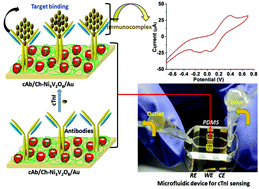A hollow-nanosphere-based microfluidic biosensor for biomonitoring of cardiac troponin I†
Abstract
Cardiovascular diseases (CVDs) are the leading causes of death worldwide. Cardiac troponin I (cTnI) is a cardiac biomarker exploited extensively for early diagnosis of acute myocardial infarction (AMI). We report a highly sensitive microfluidic biosensor for the electrochemical detection of human cTnI in real patient samples. In this device, a patterned mesoporous nickel vanadate hollow-nanosphere modified chitosan (Ch-Ni3V2O8) was integrated with a microfluidic structure. Owing to its excellent redox activity and biocompatibility, larger surface, and tunable oxidation states (V5+, V4+, and V3+), the Ch-Ni3V2O8 matrix was used to functionalize the cardiac antibodies of troponin I (cAb) and amplify the electrochemical readouts. This device offered a high sensitivity of 38.88 μA ng−1 mL−1 cm−2 at a wide range of cTnI concentrations (0.005–100 ng mL−1). A low limit-of-detection of 5 pg mL−1 and high stability, high reproducibility and good selectivity were achieved due to integration of microfluidic elements with a hollow-nanosphere Ch-Ni3V2O8. This microfluidic device can be implemented to detect B-type natriuretic peptide, myoglobin, cardiac troponin C, and cardiac troponin T by functionalizing the specific antibody recognition elements and could be used for real point-of-care applications in biomedicine.



 Please wait while we load your content...
Please wait while we load your content...